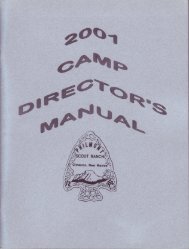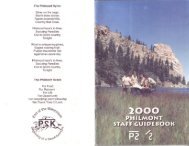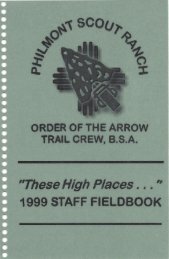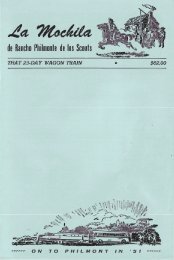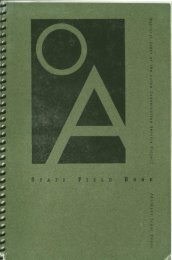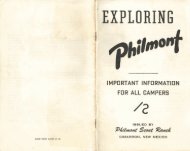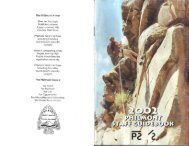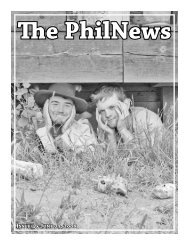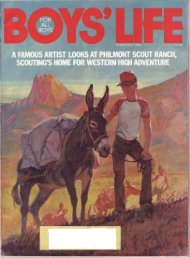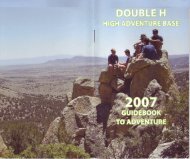Guidebook 2008.pdf
Guidebook 2008.pdf
Guidebook 2008.pdf
Create successful ePaper yourself
Turn your PDF publications into a flip-book with our unique Google optimized e-Paper software.
possible, even during the summer. Weather conditions vary from one area of<br />
the ranch to another depending upon elevation, terrain and irregular weather<br />
patterns. You should be prepared for all of the above weather conditions.<br />
Clothing<br />
During cold periods, it is especially important to stay dry since wet clothing<br />
loses much of its insulative value (90 percent or more). Several light layers<br />
of clothing are better than one heavy layer since air trapped between layers of<br />
clothing provides a high degree of insulation. As the atmosphere warms you<br />
can remove one layer of clothing at a time for proper body heat management.<br />
Keep in mind that wool and synthetics insulate when wet. Down and cotton<br />
lose most insulative value when wet. Cotton layers such as sweatshirts and<br />
sweatpants drain body heat when wet and dry very slowly.<br />
While the official BSA uniform is highly recommended for use when traveling<br />
to and from Philmont and wearing at base camp, you may choose to wear<br />
other clothing on the trail. Long pants are recommended for cold nights and<br />
are required for horseback riding and pole climbing at logging camps. Shorts<br />
and short-sleeved shirts will generally be sufficient during the day; however,<br />
a sweater or fleece jacket is necessary for cold mornings and evenings and<br />
possible downpours of rain or hail.<br />
To be comfortable and dry during rain, a good quality rain suit is essential.<br />
Inexpensive vinyl rain suits or ponchos will not hold up under extended use.<br />
A poncho is not adequate. You should have a rain jacket and pants.<br />
Lightweight, closed toe shoes are recommended for use around camp and<br />
occasionally when hiking. These shoes will also be used when rock climbing,<br />
riding horses, and biking. Sandals are not generally acceptable but can<br />
be used in campsites only.<br />
Glass and Aerosol Containers<br />
No glass containers or aerosol cans should be carried on the trail. Glass<br />
breaks easily and aerosol cans are bulky and may erupt in packs.<br />
Money<br />
Campers spend an average of $100 at Philmont's trading posts. If major<br />
items such as jackets are desired, more money will be needed.<br />
About $20 should cover most expenses on the trail. Money taken to the<br />
backcountry should be in small bills. These expenses may include:<br />
• .30-06 rifle shooting-three shots free; shotgun shooting-three shots free;<br />
additional shots must be purchased.<br />
• Youth lO-day fishing license, ages 13-17, cost determined by the state of<br />
New Mexico----about$2.50, applies only to Philmont property.<br />
• Adult fishing license; I-day, 5-day, or annual-eost determined by the<br />
state of New Mexico----about$17.00, $29.00, $61.00 (non resident). Most<br />
adults opt for the 5-day license which can be purchased in the backcountry.<br />
This requires bringing your driver's license with you on the trail, however.<br />
12<br />
• Healthy snacks, root beer, film, replacements for damaged equipment, etc.<br />
• Fuel for stoves.<br />
Sleeping Bags<br />
Your sleeping bag should be warm (suitable for temperatures down to 25<br />
degrees), but not bulky or heavy. If your sleeping bag may not be warm<br />
enough, long underwear and a stocking cap will increase your comfort on<br />
cold nights. When your sleeping bag is packed it should be no more than 20<br />
inches long and 10 inches in diameter, and it should weigh 5 pounds or less.<br />
Use a waterproof sack to store your sleeping bag and line the sack with a<br />
heavy-duty (4 to 6 mil) plastic bag safely secured to keep your sleeping bag<br />
dry even in wet weather.<br />
Boots<br />
A quality pair of broken-in hiking boots are a necessity at Philmont. Your<br />
trek may cover uneven rocky areas with many steep trails. Well broken-in<br />
boots that fit properly will keep you comfortable and prevent injuries.<br />
When fitting boots, try them on at the end of the day when your feet may<br />
be a little larger. Use the same socks you will hike in. With your feet in the<br />
boots, and laces loosened, you should be able to place two fingers behind the<br />
heel. With your socks on and your laces fully tightened, your toes should not<br />
touch the end of the boot, while standing on a 30-degree incline. Don't be<br />
surprised if your boot is one size longer and one width wider than your shoe<br />
size. Hiking boots for Philmont should be 6 to 8 inches high with a sturdy<br />
sole. Be sure to treat your boots for wet weather.<br />
Socks<br />
Two pairs of socks will be more comfortable and prevent blisters. The two<br />
pairs should not be made of the same material. Wear a thin inner sock liner<br />
and a heavier outer sock. Advisors might consider a knee high inner sock with<br />
8 to 12 mm of compression. Wool blends work very well for the outer sock.<br />
Socks made of new materials are available that are worn as a single sock.<br />
Stretching<br />
Hiking at Philmont can be as strenuous as any sport. Proper stretching before<br />
and after a hike can make your hike more enjoyable and prevent injuries.<br />
This can be extremely helpful for the Advisors and it sets a good example.<br />
Caring for your Feet<br />
Proper foot care starts before you come to Philmont. Make sure all foot<br />
problems are addressed by your family doctor or your foot specialist before<br />
arriving. While on the trail, you don't want to leave your group due to a preventable<br />
foot problem.<br />
Make sure your toenails are cut. Cut them straight across. Clean feet and<br />
socks will reduce the possibility of blisters. Wash your feet before and after<br />
hiking. Change your socks daily. Always keep you feet and socks dry. Treat<br />
13





